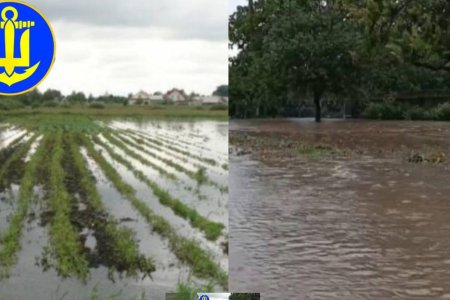
Journalist Stas Kozliuk was on Korabelna Square on Thursday afternoon when the Russians struck. He says there were around 100 people on the square, including rescuers, medics, volunteers and evacuated civilians. The Russians used artillery and Grad missiles.

Oleksandr Prokudin, the Head of the Kherson Regional Military Administration, reported that the Russians had shelled both Kherson itself and government-controlled parts of the Kherson oblast. The shelling would have been worse, had the Russians themselves not been forced to retreat because of the flooding.
In the early evening on 8 June, the Prosecutor General’s Office reported that one woman had died from Russia’s bombing of the Beryslav raion, east of Kherson. Another local resident was injured. The Prosecutor has initiated a criminal investigation under war crimes, with preliminary information suggesting that the Russians used guided missiles for their attack on civilians.
Prokudin reported constant shelling, but said that rescue efforts were continuing. 600 kilometres² were under water, with the average water lever 5,61 metres (around one a half storeys of a normal building). Of the land affected, 32% was on the right bank of the Dnipro, with 68% on the left bank, under Russian occupation.
The Russians have not shown any greater mercy to those living in areas currently under occupation. It is probably no accident as the most fatalities have been reported in occupied Oleshki, where people clung to the roofs of totally submerged homes, waiting for up to two days for any rescue efforts to begin. Judging by reports from the independent Russian publication Vazhniye Istorii [Important Stories’] the real number of deaths is likely to be much higher than the nine reported.
The imminent danger to the population was clear as soon as part of the Kakhovka Dam was destroyed (reportedly after explosions) at around 2 a.m. on 6 June. Within hours, the Ukrainian authorities began evacuation measures, with volunteers over the following days helping the Ukrainian emergency services rescue people and animals from the areas affected.
There were reports from that first day that the situation was quite different in any areas under Russian occupation, with no organized measures in place, and the Russians actively obstructing those trying to flee themselves, or with the help of volunteers.
On 7 June, Vazhniye Istorii published an article under the shocking title ‘There are bodies floating’ . Citing local residents, the authors wrote that there was no evacuation on the occupied left bank of the Dnipro, and that in Oleshki people were waiting for volunteers on the roofs of their submerged homes and were dying. Those who had managed to get out, they said, were being stopped at Russian checkpoints.
On Tuesday, 6 June, Volodymyr Saldo, the Russian-installed ‘head’ of the Kherson regional occupation administration, followed a long tradition, dating back to Soviet times, and continued by the current Russia and Russian occupation regime, namely denial. He claimed that life in general was as normal, and that no major evacuation was required. It is telling that the curfew in place was not even lifted, although people in some areas, like Oleshki would have drowned if they had sat, complying with this ‘curfew’, in their flooded homes.
Russia’s emergency services were only called in on the second day after the dam was destroyed. Even then, they did not try to get to the people clinging for their lives to roofs in Oleshki and Hola Prystan, saying that special technical gear was needed. According to Vazhniye Istorii, no evacuation from those places most badly flooded was attempted.
One of the people they spoke with called the situation critical and said that you could only make guesses as to the number of fatalities, but that there were bodies in the water, with people being pulled from their roofs by the current. There was huge demand for rescue efforts, and few people. In occupied Kakhovka, there were boats, but these were no use as the Russians were not letting them through checkpoints. “How do you save people? We wanted to order boats from Crimea, had already paid for them. Yet it’s likely that they will simply not be allowed through.” The source mentioned information that only people with Russian passports were being allowed through. A young man was trying to get his grandmother and two grandfathers out of Oleshki. Not only was there no proper evacuation, but the Russians would not allow volunteers in to rescue those that the aggressor state’s authorities were effectively abandoning.
On 8 June, Vazhniye Istorii reported, quoting volunteers, that the Russian emergencies ministry were taking volunteers’ boats from them on occupied territory, and were not allowing them to get to people who needed their help in fleeing the flooded area. The volunteers they spoke with estimated that the real number of deaths in Oleshki was in the hundreds, and not the official nine people. Yaroslav Vasilyev, coordinator of a group of volunteers, told the publication that the Russian enforcement bodies were obstructing volunteers trying to rescue people. The volunteers had sent in five boats and been turned back twice. They had tried a third time, with no news as yet as to whether they had finally succeeded.
Vasilyev says that the Russians did not move at all for two whole days. On 8 June, both the Russian military and emergency services were involved. The military had taken three boats from his volunteers. He doesn’t know why, he says, and just hopes it was to rescue people.
Volunteers say that the Russians refused to rescue 14 people from a roof in Oleshki as they don’t have Russian citizenship. Russia has long been trying to foist its citizenship on Ukrainians in occupied territory, with all kinds of threats and duress applied. Now, it appears, that they are willing to leave civilians to die if they haven’t taken on such forced citizenship.



